New European Nuclear Laboratory - Jules Horowitz Reactor
Once I talked about the MBIR reactor , which they began to build in Dimitrovgrad this year, and about the accelerator-thermonuclear neutron source IFMIF . These facilities are united by the fact that both of them are primarily powerful neutron sources, and the task of the laboratories around them is to study the behavior of matter in a neutron flux. The difference is only in the spectrum - MBIR gives a fast fission neutron spectrum, and IFMIF gives an ultrafast thermonuclear spectrum.
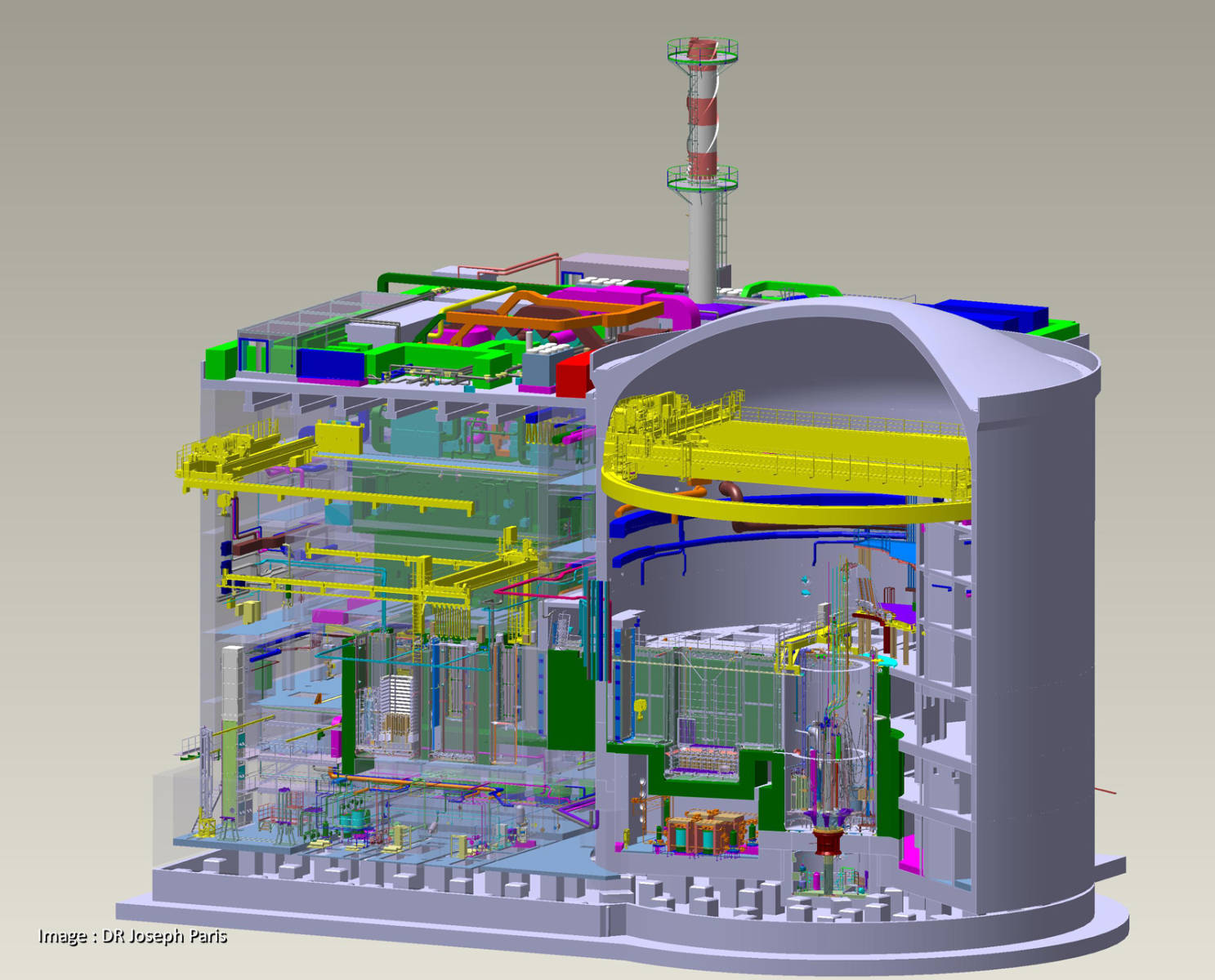
Design Image JHR. The reactor itself (its core) is an orange cylinder in the lower right third of the frame.
But it is interesting that at the same time two more record-breaking bright neutron sources are being built in the world - the Julez Horowiz Reactor (JHR) reactor with a thermal / intermediate spectrum and the ESS accelerator source with a cold / ultracold spectrum.
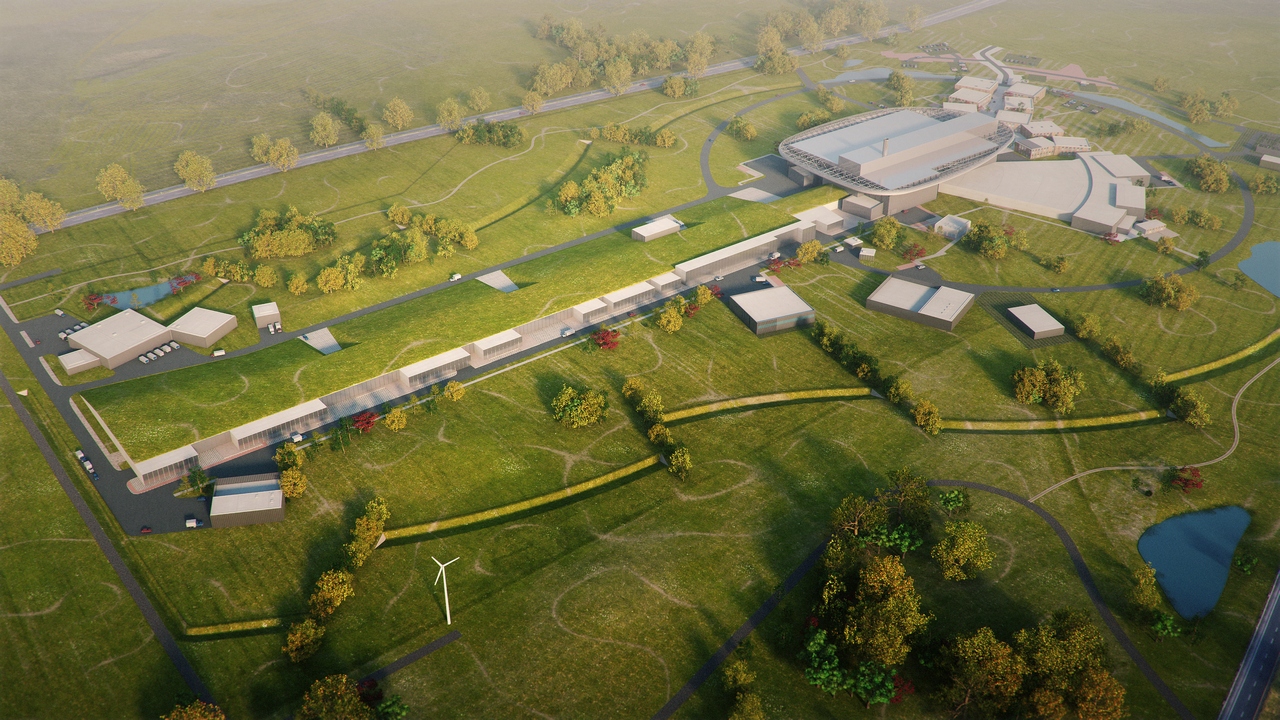
Rendering a complex of buildings ESS
4 megaprojects at once! Before proceeding to a detailed study of the chips of today's reactor, let’s talk about why this is necessary. All four plants have different specializations. IFMIF, as we recall, is an imitation of the damaging effects of brutal thermonuclear neutrons on the structural materials of future thermonuclear reactors. And ESS is a superbright (10 times brighter than MBIR and 100 JHR) source of cold and ultracold neutrons, which will be used in fundamental and applied research in the field of condensed matter physics. MBIR, in turn, is a full-fledged test bench for future fast reactors, with high brightness and dose rate. JHR plays the same role for future thermal spectrum reactors - primarily water reactors.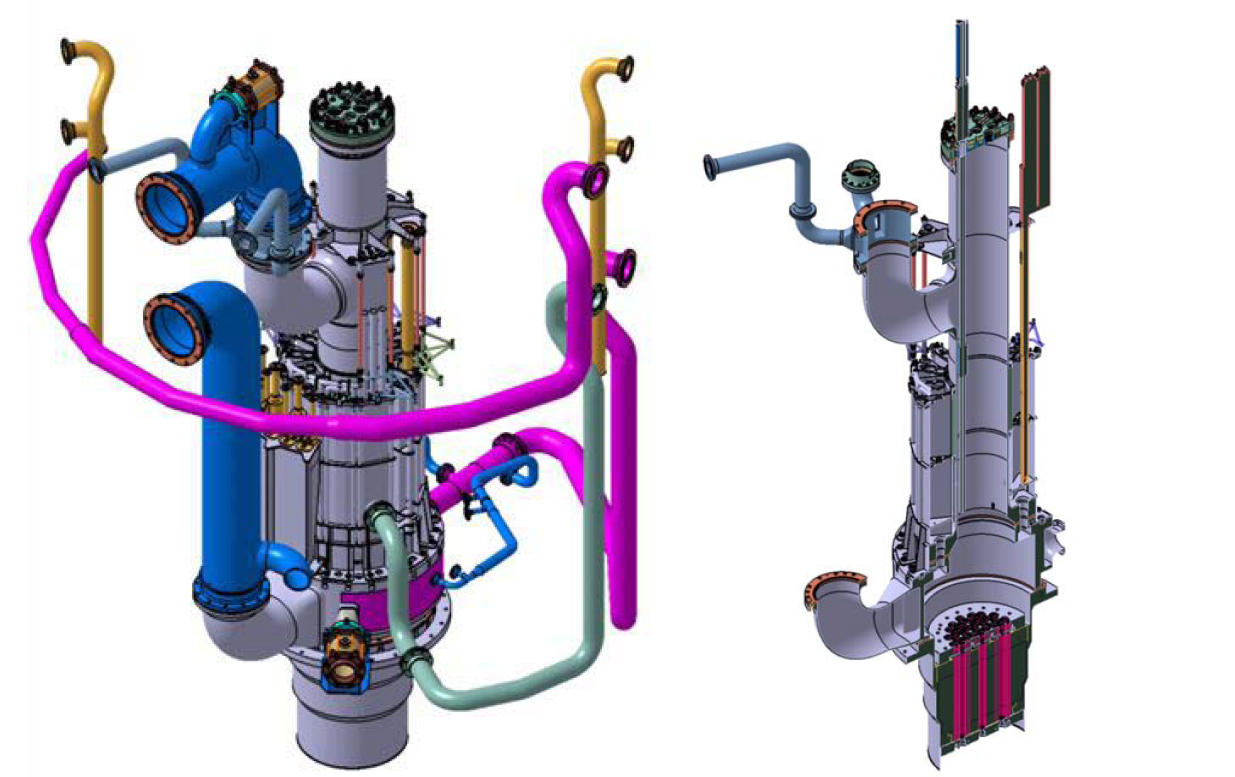
Design image of the reactor vessel, without core. Blue pipes - the main cooling, pink - spare.
So, the reactor, named after the French scientist and atomic functionary of Polish origin Jules Horowitz will be a very advanced laboratory that will replace the fleet of aging French and European research reactors. This complex is being built in the Kadarash Nuclear Center, 2 km away. from ITER. ITER in the foreground, and at the top, in the center of the frame, the JHR construction is visible
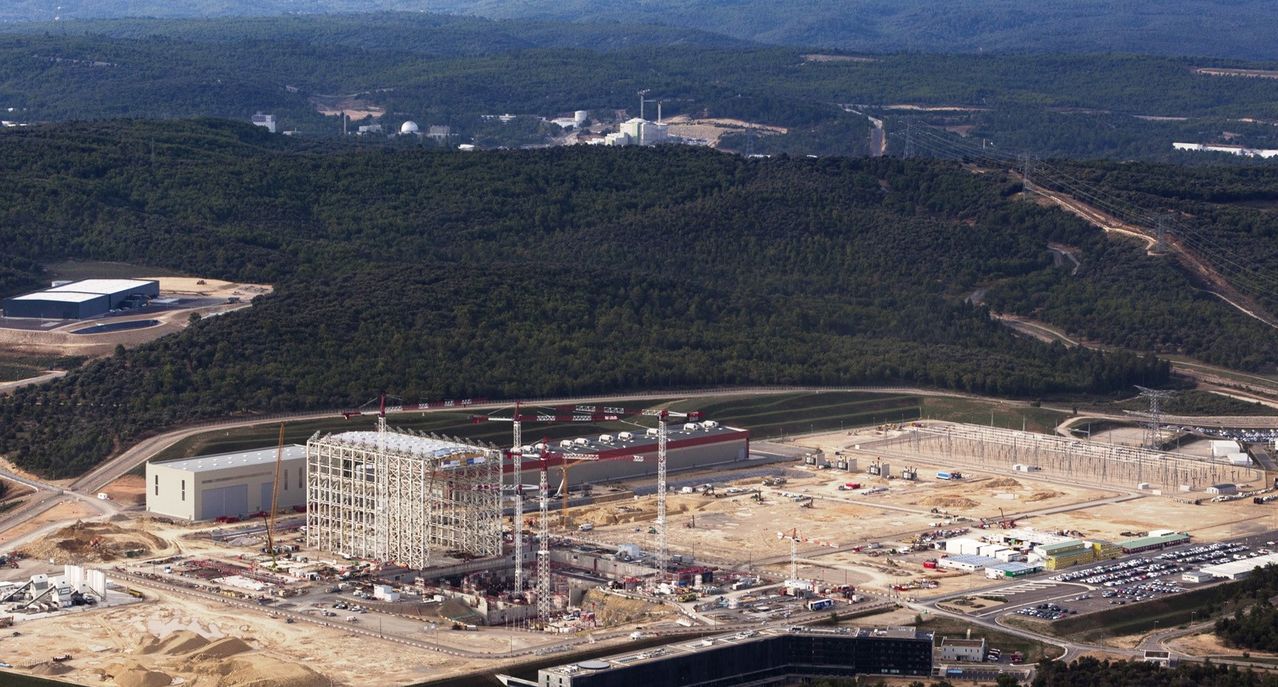
A billion-euro-worth JHR laboratory will be based on a ~ 100 megawatt reactor with a dense core surrounded by a beryllium reflector. It has a rather unusual AZ configuration, with an irregular array with 37 positions for fuel assemblies (fuel assemblies), ring fuel rods (fuel assemblies composed of 8 concentric cylinders) and many positions for irradiating targets and devices.
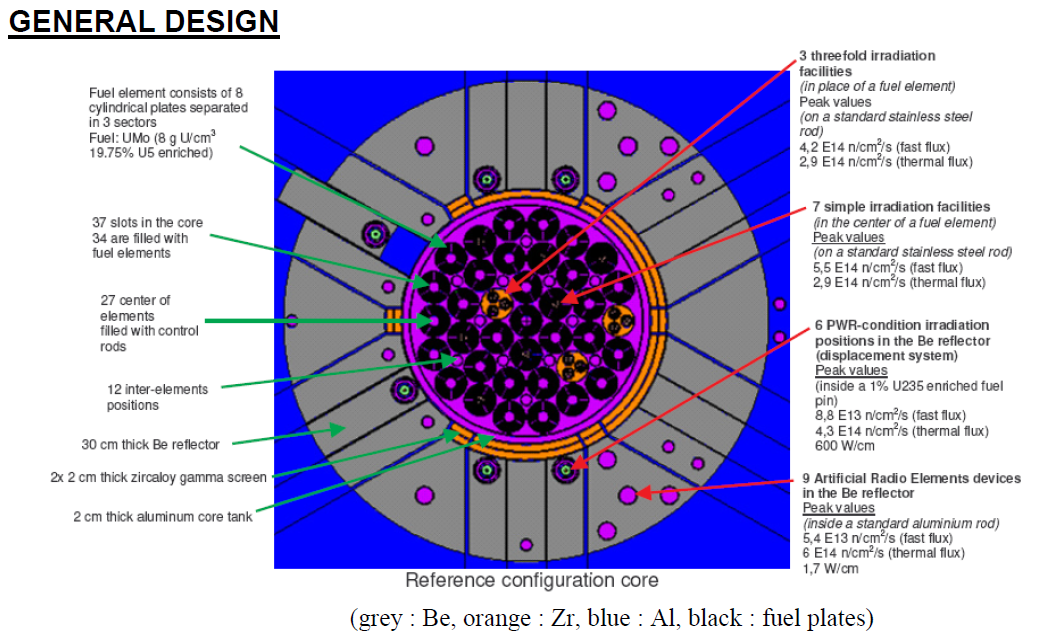
The core section: gray - beryllium reflector, orange - irradiation devices, pink - coolant, black - fuel assembly,
27 absorbing hafnium rods can be introduced into the center of a fuel assembly for power control and emergency quenching of a chain reaction. The reactor’s fuel will be uranium enriched up to 20% in 235 isotope (politicians like this enrichment because it does not allow making a nuclear bomb, but reduces the maximum achievable neutron flux.). This machine, like the bulk of research reactors (IR), will run campaigns from 30 to 70 days, stopping overloading, primarily irradiation devices, in which experiments will be conducted.
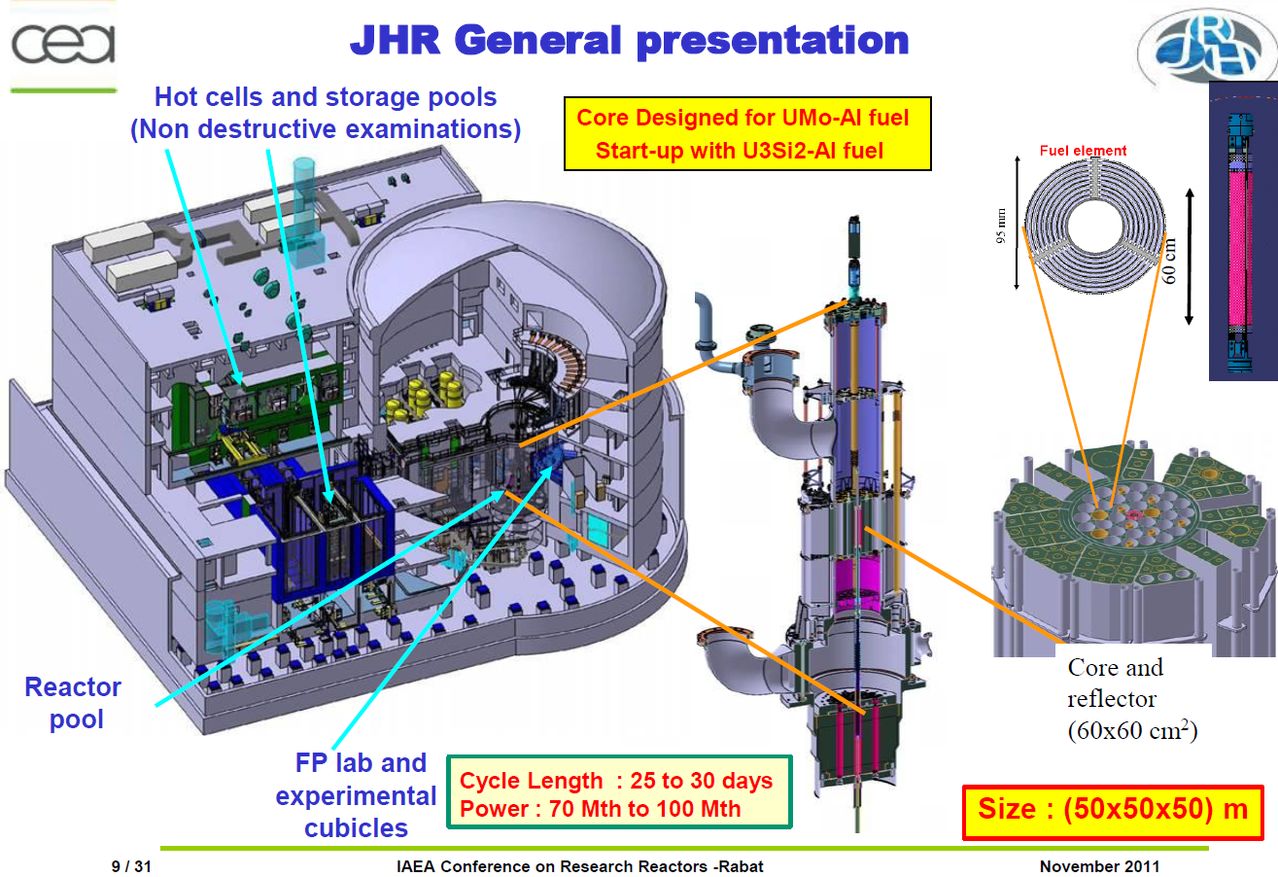
All together: a building with laboratories and a reactor, a reactor vessel, an active zone with a diffuser, from the top right - fuel assemblies, a section and the whole.
Reactor cooling - forced circulation of water with a pressure of 5-7 atm with a temperature of 120 ° C with the discharge of heat into the heat exchanger of the secondary circuit. The second circuit is cooled by external running water.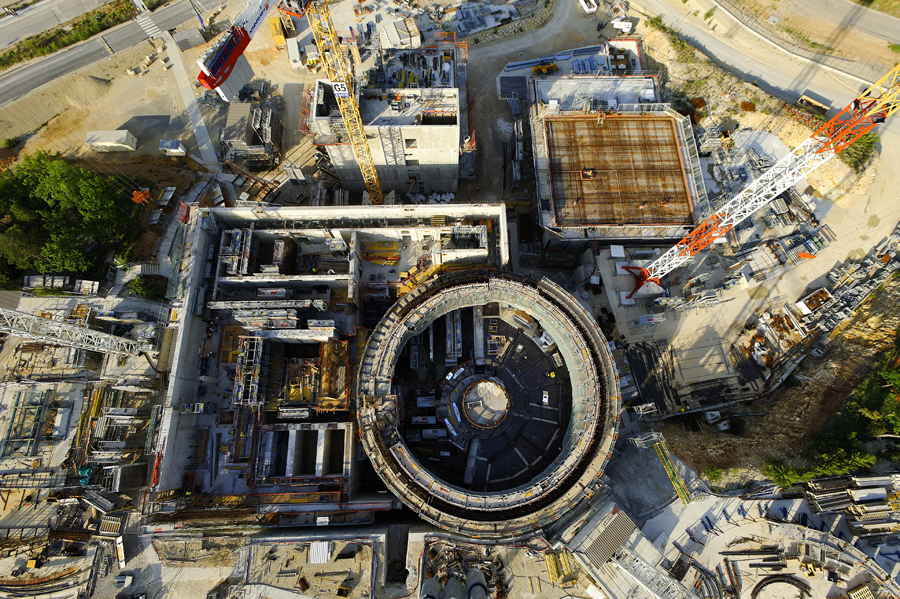
Construction of the JHR building in 2013.
What tasks will this reactor solve?
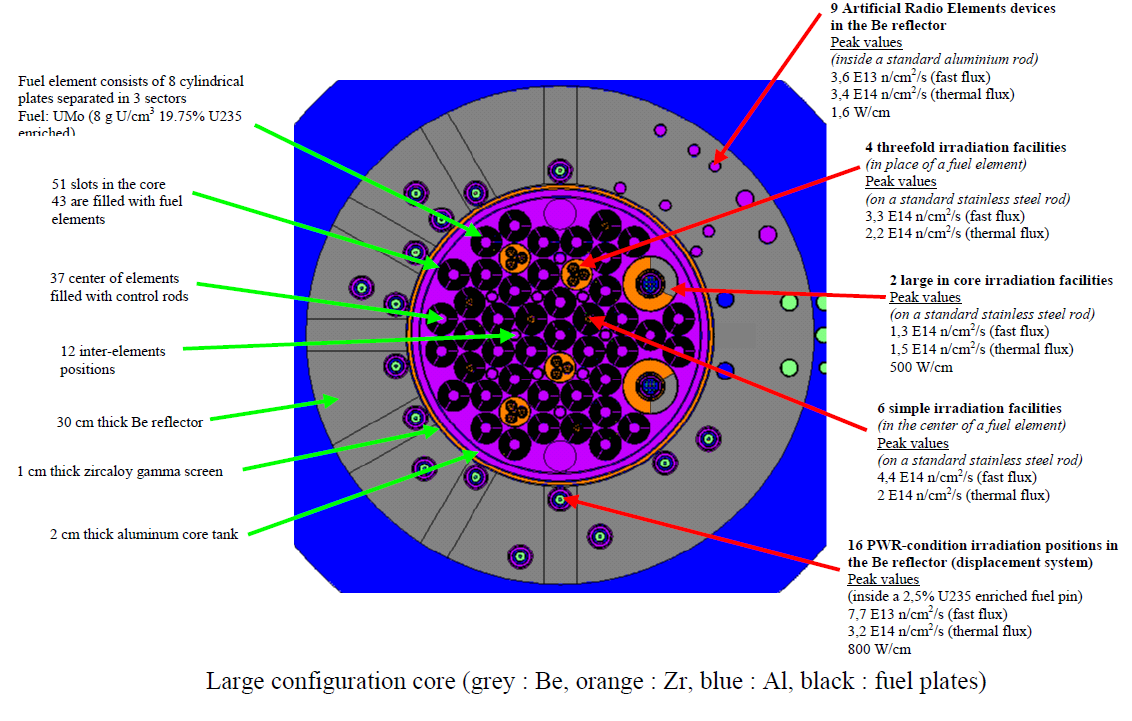
The second configuration of the AZ is with two large loop devices that allow you to simulate the operation of a fuel assembly of a reactor with a non-aqueous coolant.
The cunning core of the reactor can be widely reconfigured for different irradiation tasks. You can put two large loop channels with their own coolants, four irradiation devices will replace the fuel assemblies, and several more small capsules with a diameter of 32 mm can be inserted inside other fuel assemblies. However, this reduces the neutron flux. If serious doses are needed, then 3 medium irradiation devices with a diameter of 92 mm and 7 inserts in a fuel assembly can be used.

Points at which irradiation of samples and devices during reactor operation is possible (green and red)
Regardless of this configuration, in the reflector around the AZ there are 6 positions in the displacing devices (about them - below) and 10 positions in the reflector for producing isotopes, nuclear-doped silicon and studies that do not require powerful neutron fluxes and high temperature. Large irradiation devices in the reactor and reflector can be connected to laboratory equipment outside the reactor - both by electrical connections and by pipelines with a coolant or to transport some chemistry from the inside of the target to mass spectrographs.
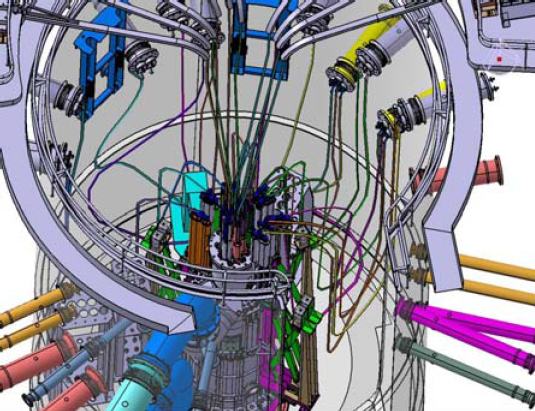
Design image of connecting the irradiation devices of the reactor to external equipment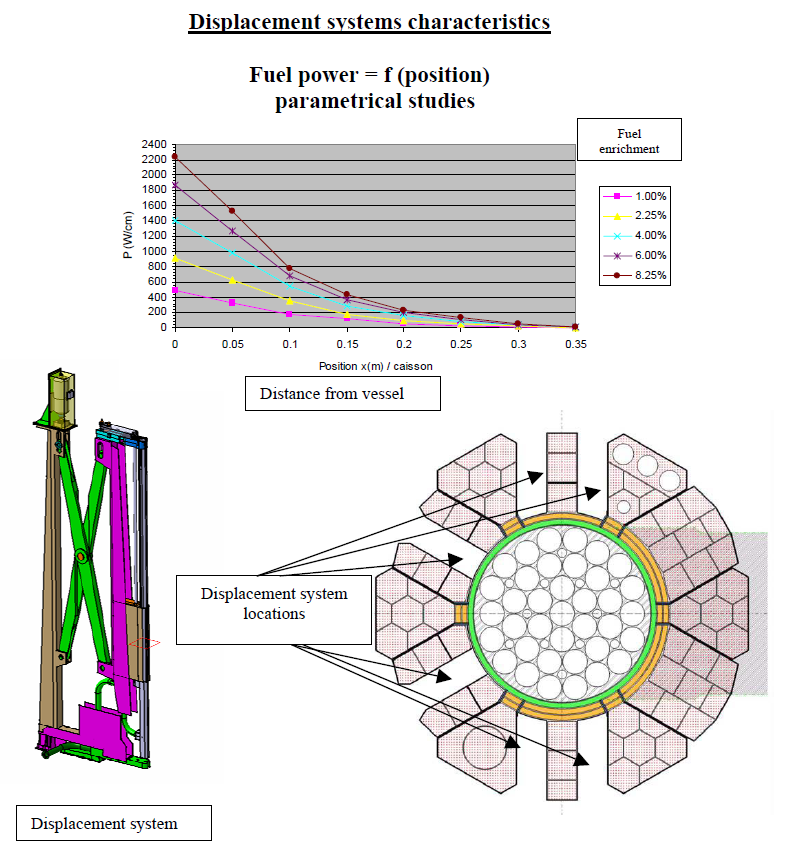
Displacing device (left), the schedule of energy release in different fuels depending on the distance from the AZ and the location of the WU in the reactor reflector.
Now about displacing plants, which are a chip of the reactor. These are movable structures capable of pushing and pushing the irradiated structure into the neutron flux. This approach allows you to simulate a reactive accident, for example, if a stream of water somehow squeezes the control rod out of the reactor or a plug of pure (without boric acid) condensate passes through the reactor. Here you can simulate the dynamic processes in the fuel - heating, cooling, cycles.
View of the reactor in a working configuration from above. It can be seen how much the reactor is studded with experimental remedies, and why the coolant was removed sideways.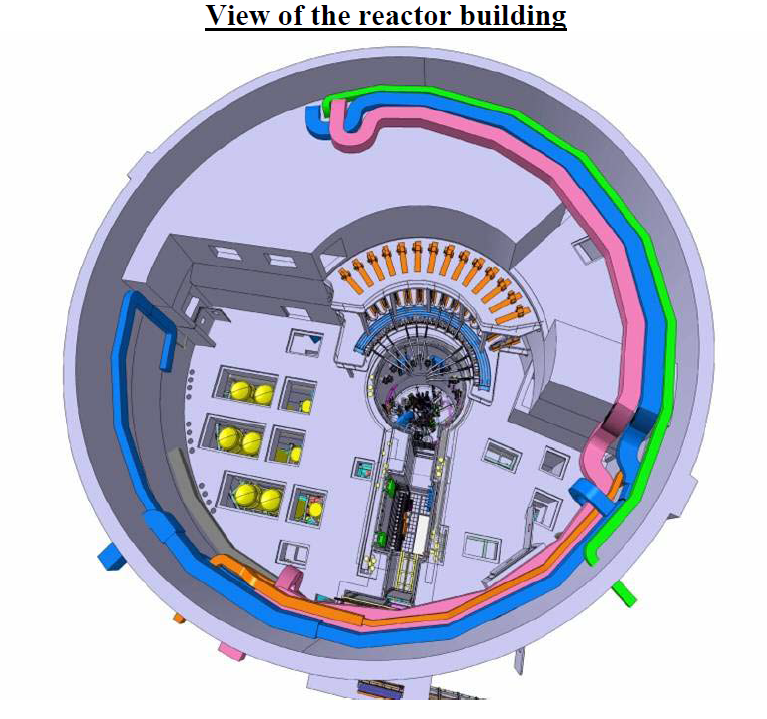
Sealed reactor compartment. The reactor itself, heat exchangers (yellow cylinders), a transport pool for SNF and irradiated devices are visible.
Here it is worth making a short stop and explaining that there are no reactors in the world capable of simultaneously providing such a variety of positions, large fluxes, and high productivity in irradiation experiments. JHR in this aspect is truly an outstanding machine. A typical optimization task looks like this: it is necessary to ensure a high neutron flux, and therefore a liter capacity of the reactor (for JHR FAs it will be 600 kW / liter - five times more than in VVER-1000), while using as little water as possible for cooling (in order to increase the spectrum stiffness and reduce the absorption of neutrons by water), but do not lift the temperature and pressure of cooling water for safety reasons. And at the same time provide many configurations of AZ with different experimental materials and designs introduced here.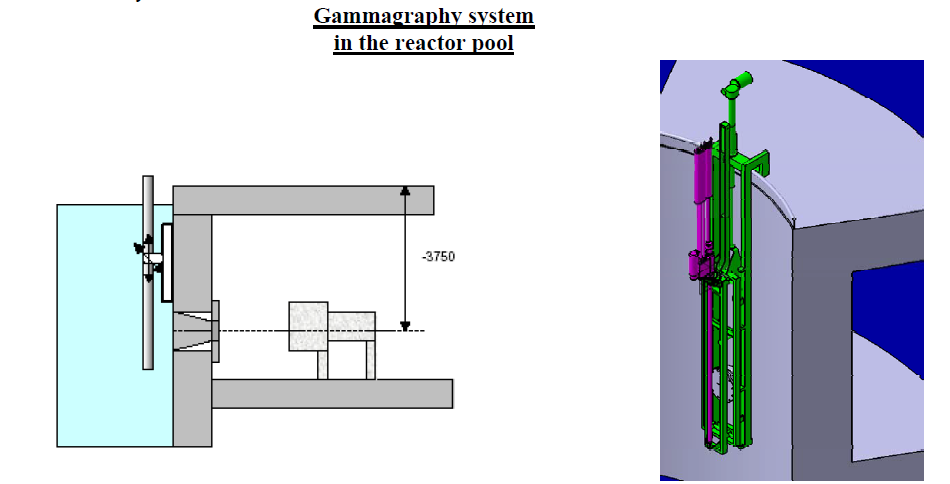
A device for moving an irradiated fuel element in front of a gamma camera.
By the way, irradiation devices are also no less high-tech machines, in which it is possible to test fuel elements for destruction, study radiation corrosion, carry out transmutation of minor actinides, study materials of future reactors at high temperatures and neutron radiation, etc. etc. Many of the irradiation devices have instrumentation - i.e. they are equipped with sensors, actuators (how do you like a machine that allows you to test samples directly in the reactor for tearing?), valves and more.

A variety of irradiation devices for simulating emergency operations (LORELEI - loss of coolant), studying radiochemistry and fuel physics, transmutation of targets, etc.
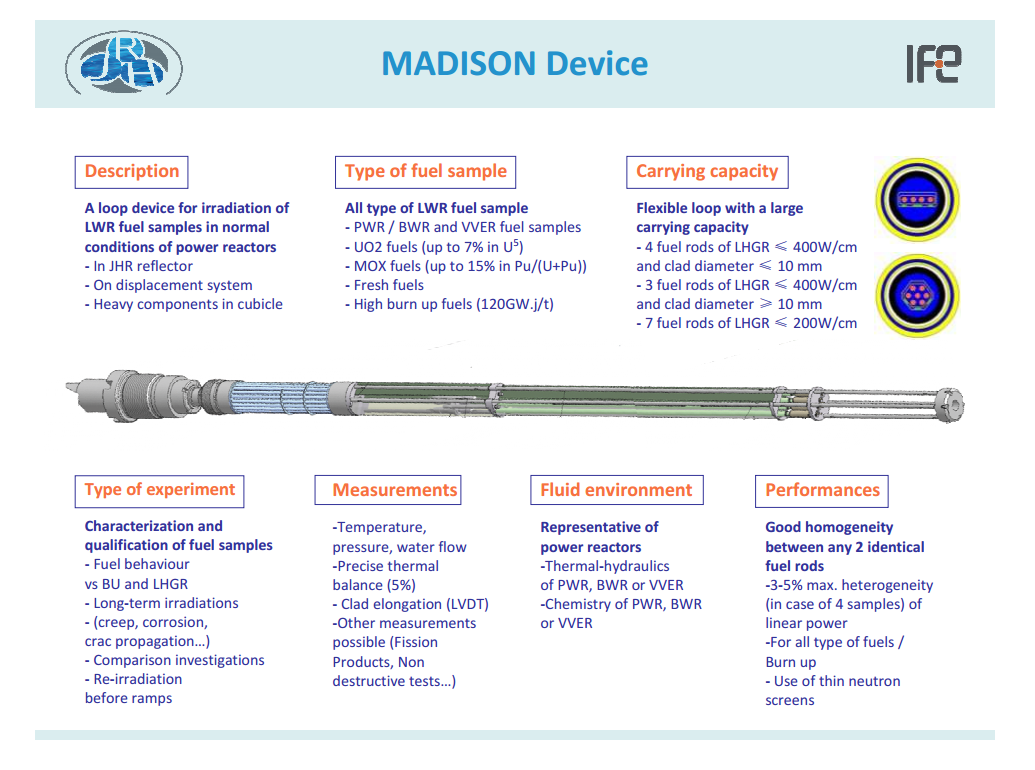
A device for the study of fuel elements for conventional power reactors. Allows you to study neutron physics, cracking and other mechanical changes, radiochemistry and radiolysis corrosion, thermohydraulics and water-chemical regime. It is equipped with a heat exchanger and heaters to set the desired coolant mode.
However, JHR is not only a reactor. Around it are located first-class radiochemical laboratories. Hot chambers are also located here, which make it possible to study irradiated targets, devices, structures, and to equip other targets and fuel rods with non-destructive and destructive methods.
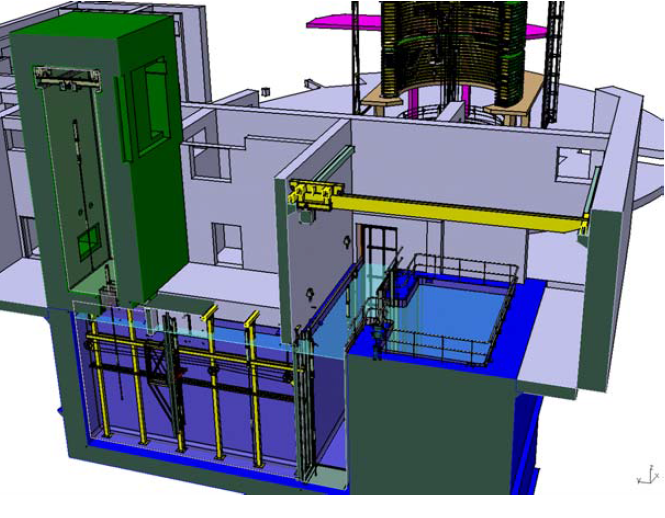
Reactor (in the background), transport pools, holding pool and hot chambers (green)
Next to the reactor is also a pool for storing irradiated fuel, to which again sensors and lines can be connected to study radiochemical changes in SNF. Finally, separate laboratories are needed to connect the irradiation devices located in the reactor, as I mentioned above. The instruments located here will allow us to constantly study the chemical and physical changes in the irradiated samples.
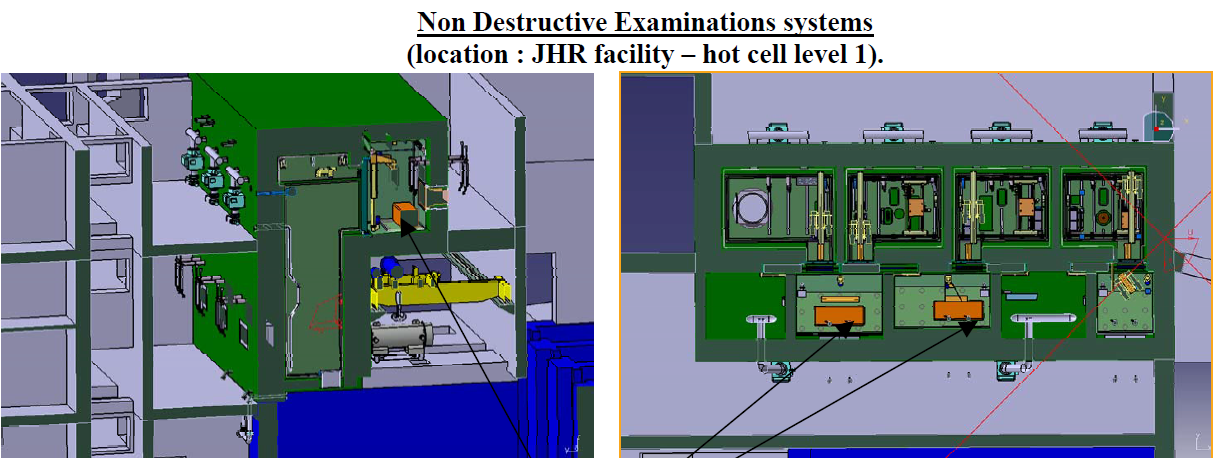
Hot cameras will be equipped with a variety of research equipment, including ultrasound and X-ray cameras for non-destructive testing (orange)
In general, the capabilities of one JHR draw on about half of the capabilities of the entire RIAR park (where 6 reactors are currently operating - SM, MIR, BOR-60, RBT-10/1, RBT-6) or other strong world research centers (the same Kadarash or Saklai ) The construction begun in 2007 is already completed - the equipment is being installed. Very soon - in 2016, fuel loading and physical start-up are expected, with access to the first irradiation campaign at the end of 2017.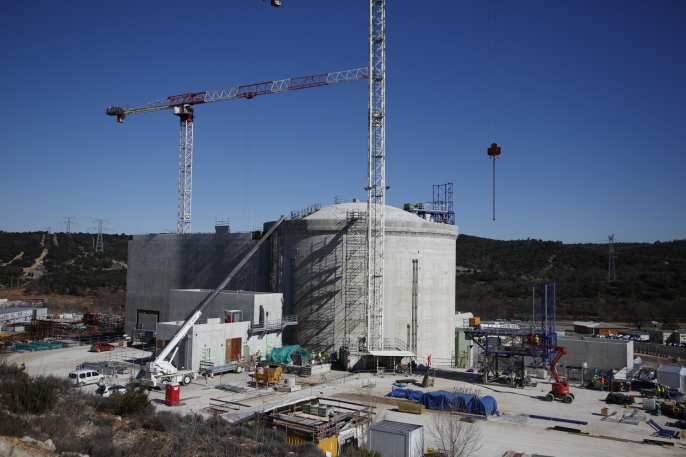
The construction of the JHR building was completed in February 2015.

Design Image JHR. The reactor itself (its core) is an orange cylinder in the lower right third of the frame.
But it is interesting that at the same time two more record-breaking bright neutron sources are being built in the world - the Julez Horowiz Reactor (JHR) reactor with a thermal / intermediate spectrum and the ESS accelerator source with a cold / ultracold spectrum.

Rendering a complex of buildings ESS
4 megaprojects at once! Before proceeding to a detailed study of the chips of today's reactor, let’s talk about why this is necessary. All four plants have different specializations. IFMIF, as we recall, is an imitation of the damaging effects of brutal thermonuclear neutrons on the structural materials of future thermonuclear reactors. And ESS is a superbright (10 times brighter than MBIR and 100 JHR) source of cold and ultracold neutrons, which will be used in fundamental and applied research in the field of condensed matter physics. MBIR, in turn, is a full-fledged test bench for future fast reactors, with high brightness and dose rate. JHR plays the same role for future thermal spectrum reactors - primarily water reactors.

Design image of the reactor vessel, without core. Blue pipes - the main cooling, pink - spare.
So, the reactor, named after the French scientist and atomic functionary of Polish origin Jules Horowitz will be a very advanced laboratory that will replace the fleet of aging French and European research reactors. This complex is being built in the Kadarash Nuclear Center, 2 km away. from ITER. ITER in the foreground, and at the top, in the center of the frame, the JHR construction is visible

A billion-euro-worth JHR laboratory will be based on a ~ 100 megawatt reactor with a dense core surrounded by a beryllium reflector. It has a rather unusual AZ configuration, with an irregular array with 37 positions for fuel assemblies (fuel assemblies), ring fuel rods (fuel assemblies composed of 8 concentric cylinders) and many positions for irradiating targets and devices.

The core section: gray - beryllium reflector, orange - irradiation devices, pink - coolant, black - fuel assembly,
27 absorbing hafnium rods can be introduced into the center of a fuel assembly for power control and emergency quenching of a chain reaction. The reactor’s fuel will be uranium enriched up to 20% in 235 isotope (politicians like this enrichment because it does not allow making a nuclear bomb, but reduces the maximum achievable neutron flux.). This machine, like the bulk of research reactors (IR), will run campaigns from 30 to 70 days, stopping overloading, primarily irradiation devices, in which experiments will be conducted.

All together: a building with laboratories and a reactor, a reactor vessel, an active zone with a diffuser, from the top right - fuel assemblies, a section and the whole.
Reactor cooling - forced circulation of water with a pressure of 5-7 atm with a temperature of 120 ° C with the discharge of heat into the heat exchanger of the secondary circuit. The second circuit is cooled by external running water.

Construction of the JHR building in 2013.
What tasks will this reactor solve?
- Search for new materials with higher permissible operating temperatures and damaging doses. Such materials open the way to completely new reactor concepts, such as a candle reactor.
- The study of the limits of the health of existing materials, their life tests and behavior in emergency situations
- The irradiation of experimental fuel compositions and fuel elements is a study of the chemistry, physics, and construct of these new solutions. In fact, at this reactor one can investigate the fuel element design for all existing reactors.
- Existing and future fuel behavior in emergency situations.
- A study in the interests of future non-water coolant reactors - gas, liquid metal, liquid salt loops with core elements immersed there.
- Fast reactors - materials, coolants, even fuel elements.
- The accumulation of up to ¼ of the European need for regular isotopes and up to 50% of “specific” isotopes.
- And of course, the methodological and metrological support of the nuclear industry - constants, parameters, solution verification, etc.

The second configuration of the AZ is with two large loop devices that allow you to simulate the operation of a fuel assembly of a reactor with a non-aqueous coolant.
The cunning core of the reactor can be widely reconfigured for different irradiation tasks. You can put two large loop channels with their own coolants, four irradiation devices will replace the fuel assemblies, and several more small capsules with a diameter of 32 mm can be inserted inside other fuel assemblies. However, this reduces the neutron flux. If serious doses are needed, then 3 medium irradiation devices with a diameter of 92 mm and 7 inserts in a fuel assembly can be used.

Points at which irradiation of samples and devices during reactor operation is possible (green and red)
Regardless of this configuration, in the reflector around the AZ there are 6 positions in the displacing devices (about them - below) and 10 positions in the reflector for producing isotopes, nuclear-doped silicon and studies that do not require powerful neutron fluxes and high temperature. Large irradiation devices in the reactor and reflector can be connected to laboratory equipment outside the reactor - both by electrical connections and by pipelines with a coolant or to transport some chemistry from the inside of the target to mass spectrographs.

Design image of connecting the irradiation devices of the reactor to external equipment

Displacing device (left), the schedule of energy release in different fuels depending on the distance from the AZ and the location of the WU in the reactor reflector.
Now about displacing plants, which are a chip of the reactor. These are movable structures capable of pushing and pushing the irradiated structure into the neutron flux. This approach allows you to simulate a reactive accident, for example, if a stream of water somehow squeezes the control rod out of the reactor or a plug of pure (without boric acid) condensate passes through the reactor. Here you can simulate the dynamic processes in the fuel - heating, cooling, cycles.

View of the reactor in a working configuration from above. It can be seen how much the reactor is studded with experimental remedies, and why the coolant was removed sideways.

Sealed reactor compartment. The reactor itself, heat exchangers (yellow cylinders), a transport pool for SNF and irradiated devices are visible.
Here it is worth making a short stop and explaining that there are no reactors in the world capable of simultaneously providing such a variety of positions, large fluxes, and high productivity in irradiation experiments. JHR in this aspect is truly an outstanding machine. A typical optimization task looks like this: it is necessary to ensure a high neutron flux, and therefore a liter capacity of the reactor (for JHR FAs it will be 600 kW / liter - five times more than in VVER-1000), while using as little water as possible for cooling (in order to increase the spectrum stiffness and reduce the absorption of neutrons by water), but do not lift the temperature and pressure of cooling water for safety reasons. And at the same time provide many configurations of AZ with different experimental materials and designs introduced here.

A device for moving an irradiated fuel element in front of a gamma camera.
By the way, irradiation devices are also no less high-tech machines, in which it is possible to test fuel elements for destruction, study radiation corrosion, carry out transmutation of minor actinides, study materials of future reactors at high temperatures and neutron radiation, etc. etc. Many of the irradiation devices have instrumentation - i.e. they are equipped with sensors, actuators (how do you like a machine that allows you to test samples directly in the reactor for tearing?), valves and more.

A variety of irradiation devices for simulating emergency operations (LORELEI - loss of coolant), studying radiochemistry and fuel physics, transmutation of targets, etc.

A device for the study of fuel elements for conventional power reactors. Allows you to study neutron physics, cracking and other mechanical changes, radiochemistry and radiolysis corrosion, thermohydraulics and water-chemical regime. It is equipped with a heat exchanger and heaters to set the desired coolant mode.
However, JHR is not only a reactor. Around it are located first-class radiochemical laboratories. Hot chambers are also located here, which make it possible to study irradiated targets, devices, structures, and to equip other targets and fuel rods with non-destructive and destructive methods.

Reactor (in the background), transport pools, holding pool and hot chambers (green)
Next to the reactor is also a pool for storing irradiated fuel, to which again sensors and lines can be connected to study radiochemical changes in SNF. Finally, separate laboratories are needed to connect the irradiation devices located in the reactor, as I mentioned above. The instruments located here will allow us to constantly study the chemical and physical changes in the irradiated samples.

Hot cameras will be equipped with a variety of research equipment, including ultrasound and X-ray cameras for non-destructive testing (orange)
In general, the capabilities of one JHR draw on about half of the capabilities of the entire RIAR park (where 6 reactors are currently operating - SM, MIR, BOR-60, RBT-10/1, RBT-6) or other strong world research centers (the same Kadarash or Saklai ) The construction begun in 2007 is already completed - the equipment is being installed. Very soon - in 2016, fuel loading and physical start-up are expected, with access to the first irradiation campaign at the end of 2017.

The construction of the JHR building was completed in February 2015.
